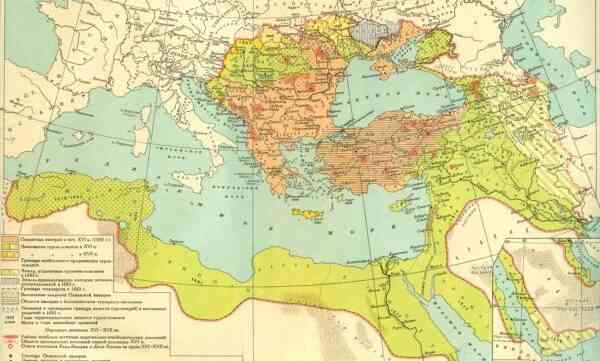The mighty Ottoman Empire that existed for many centuries disappeared from the political maps of the world only in the 20th century. Once she controlled the vast territories of Asia, Europe and the East, capturing new lands and gaining a foothold on them. However, world history has made its own adjustments, and now only numerous cultural and historical monuments, of which a great many have been preserved in modern Turkey, remind of those times.
Facts about the Ottoman Empire
- It existed for more than 6 centuries – a huge period, given that many large states, assembled from various lands, like a patchwork quilt, usually fell apart much faster.
- During its heyday, at the turn of the 16th and 17th centuries, the area of the Ottoman Empire was only slightly less than 20 million square kilometers. This is about 2.5 million sq. km. more than the area of modern Russia.
- The northern borders of the Ottoman Empire extended to the territories now occupied by Austria, Poland and Lithuania (interesting facts about Austria).
- In its expanses they spoke different languages, as the rulers conquered many different peoples. The Ottoman language was considered the main language, partly close to modern Turkish.
- For 8 months, the Ottoman Empire was officially called the Ottoman Caliphate.
- Fearing competition from blood relatives, in the Ottoman Empire, rulers usually executed all siblings who could claim the throne. The law was applied for about two hundred years, but was later relaxed, and death was replaced by life imprisonment.
- The First World War led to the final collapse of the Ottoman Empire, whose successor was Turkey. Its former possessions are now independent states – Algeria, Serbia, Montenegro, Albania, Egypt and many other countries (interesting facts about Turkey).
- It was from this country that tulips, which the Netherlands is now so famous for, came to Europe.
- The crescent, now a symbol of Islam in Muslim countries, became it in the Ottoman Empire.
- For citizens of the empire who were not Muslims, additional taxes were created that they had to pay.
- All Ottoman sultans had extensive harems. Some of them had up to 2,000 women.
- Ottoman Sultan Selim the Terrible entered history, during which many great viziers were replaced. This position was very honorable, the Grand Vizier is the right hand of the Sultan. However, Selim the Terrible executed the viziers even for petty offenses, so no one voluntarily wanted to occupy this position with him. And those who had to, carried a will with them. So, just in case.
- The role of the capital of the Ottoman Empire in different eras was performed by different cities. For the longest time, more than 450 years, it was Istanbul (interesting facts about Istanbul).
- A person sentenced to death had the right to demand a trial instead of execution. If he managed to run to the city gates ahead of the executioner chasing him, he was released.
- The personal power of the rulers in the Ottoman Empire was seriously limited from the end of the 19th century.
- In this state, Christians and Jews did not have the right to ride a horse or carry weapons. This was allowed only for Muslims.
- Poetry in the Ottoman Empire was very popular, but the first novels and stories appeared only at the beginning of the 19th century.
- Istanbul became the Ottoman capital after the Turks- The Ottomans stormed Constantinople, the ancient capital of Byzantium. They did not plunder the city, but settled in it, renamed and even moved the Sultan’s residence here.
